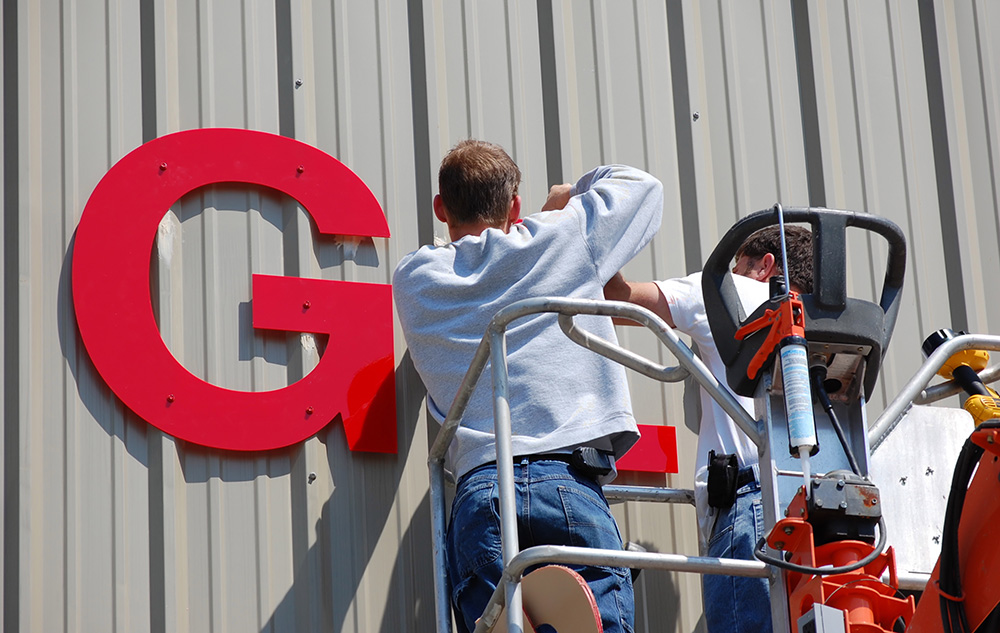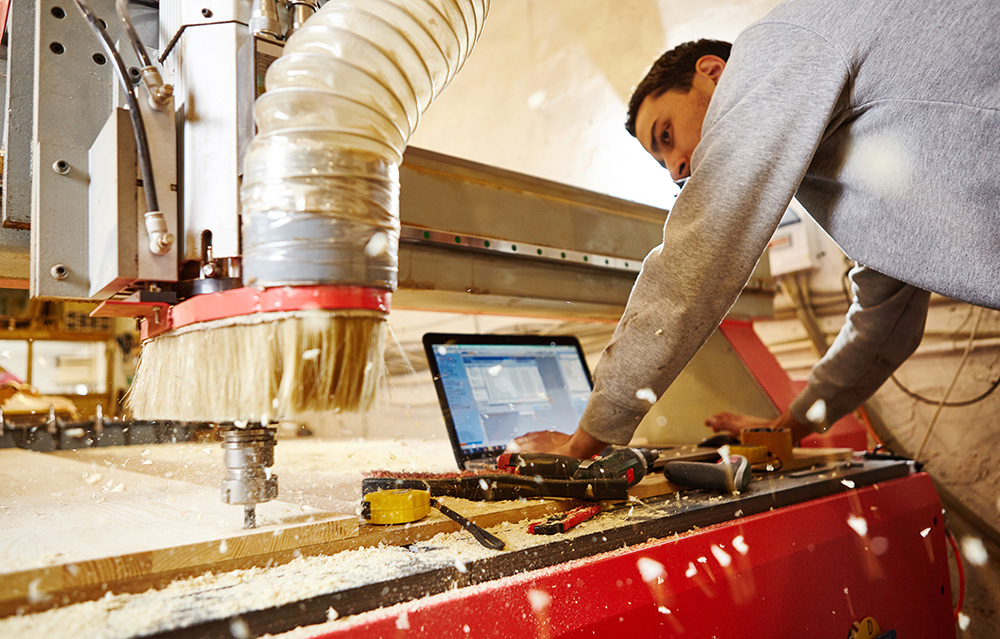Keep equipment up to date and in good condition. Photo: Shutterstock.com/il21.
Ensuring the safety of your sign teams, whether they’re working inside the shop or out on installation sites, should always remain a paramount concern. The shop floor, with its hazardous chemicals, heavy equipment, and sharp tools, can be a perilous environment, and the repercussions of employee illness or injury can be both costly and disruptive.
Furthermore, high-volume workloads and rushed projects can significantly heighten the risk of accidents such as slips, falls, or severe cuts. Your liability also increases if a customer is involved in any mishap.
To mitigate these risks and reduce associated costs, it’s crucial to provide your employees with proper safety training. The good news is that this doesn’t necessarily require a significant financial investment or extensive time spent in meetings discussing safety procedures. What it truly demands from everyone is a consistent state of awareness.
 Workers install a sign on the side of an industrial building. Photo: Shutterstock.com/Greg Henry
Workers install a sign on the side of an industrial building. Photo: Shutterstock.com/Greg Henry
Let’s enhance the text for greater impact and clarity:
Consider the substantial costs associated with a lack of vigilance:
In 2019, employers bore a staggering burden, forking out over $1 billion per week in workers’ compensation costs alone, as reported by the Occupational Safety and Health Administration.
The gravity of the situation becomes even more apparent when we take into account the total expenses. This includes worker’s compensation, medical bills, and the loss of productivity, which collectively reached an astonishing $171 billion during that year, as per data from the National Safety Council.
The National Safety Council paints a grim picture by revealing that a worker suffers an on-the-job injury every seven seconds.
Notably, our industry, which encompasses manufacturing and production, ranks as the third highest in terms of worker injury rates. Furthermore, our involvement in the transportation/shipping and installation/maintenance sectors places us within the second and fourth highest risk categories, respectively.
Recognizing the severity of these figures, the Occupational Safety and Health Administration, in its “Business Case for Safety and Health,” underscores the potential of effective safety training to substantially reduce injuries, illnesses, and their associated financial burdens while simultaneously enhancing overall productivity and profitability.
At Signarama, we are fully committed to the safety of our workforce. To this end, we have implemented a mandatory safety training program conducted by our corporate training team. This program is designed to comprehensively address all potential hazards encountered within a sign shop, ranging from fall prevention to ergonomic safety. We firmly believe that it encompasses every essential element of an effective training program – it’s comprehensive, hazard-focused, and tailored to the specific needs of our employees.
Moreover, our approach to training your sign team prioritizes engagement and simplicity. We recognize the importance of ensuring that the training is not only easy to understand but also provides employees with opportunities to put their newly acquired knowledge into practice.
 Professional cutting tools. Photo: Shutterstock.com/Tereshchenko Dmitry
Professional cutting tools. Photo: Shutterstock.com/Tereshchenko Dmitry
Here are some valuable tips to promote a culture of daily safety within your shop and on job sites:
- Ingrain Safety as a Daily Habit: Train your employees in safety procedures as a daily practice. At my Signarama franchise in Covina, California, we prioritize safety training from day one. New employees spend their first week with the store’s production manager, who not only acquaints them with proper procedures but also instills safety as an integral part of the job. Consistently reinforce safety measures every day to ensure they become second nature to your team.
- Prioritize Cleanliness: A clean shop is a safer shop. It’s easy to let standards slip on busy workdays, but maintaining cleanliness is crucial. Ensure that your employees keep their workspaces tidy, especially after completing a task. Leaving tools and material scraps on the floor creates tripping and slipping hazards. An organized workspace also enhances productivity by preventing time wasted searching for essential tools.
- Customer-Focused Separation: Maintain a clear separation between the shop floor and the customer service area to prevent customers from entering potentially hazardous zones. If customers have visibility into the work area, it’s paramount that the space is consistently clean and well-organized. A disorderly shop can give customers reservations about doing business with you, so presentation matters.
- Ensure Offsite Safety: Extend your commitment to safety to offsite work as well. Insist that your teams adhere to safety regulations such as limits on ladder height, the use of safety cones, and the proper securing of work areas with “Do Not Cross” tape or signage. This not only protects your employees but also prevents non-employees from wandering into potentially dangerous areas.
By consistently implementing these practices, you’ll create a safer and more efficient work environment both within your shop and on job sites.
 Two workers installing a new sign at an Albertsons location at Oakway Center. Photo: Shutterstock.com/Joshua Rainey Photography.
Two workers installing a new sign at an Albertsons location at Oakway Center. Photo: Shutterstock.com/Joshua Rainey Photography.
Ensure the Right Tools and Equipment:
- Utilize Proper Equipment: Provide the appropriate tools for each job, and ensure that your equipment is up to date and well-maintained. For example, dispose of any straight edges that are missing their protective guard pieces to prevent potential accidents.
- Plan for Equipment Failures: Despite your best efforts, equipment failures are inevitable. Establish a contingency plan for such situations to minimize downtime and disruptions.
- Blade Safety: Mandate that cutting blades always be stored with their caps on. As a precaution, offer an alternative storage method, such as a Styrofoam™ block, for those moments when the cap goes missing.
Promote Responsibility and Accountability:
- Shared Responsibility: While it’s your responsibility to provide the necessary resources for job safety, emphasize that safety is a collective effort. Everyone in the shop is accountable for maintaining a safe working environment.
- Site Supervisor: Appoint a site supervisor tasked with monitoring compliance with safety regulations. When safety protocols are not followed, ensure that infractions are documented, and develop corrective plans to prevent repeated errors.
Prioritize Employee Well-Being:
- Training for Safety: Prioritize the training of your sign teams on the importance of staying safe. This not only protects your business from the high costs associated with medical care and lost productivity but, more importantly, safeguards the well-being of your valuable employees.
- Emphasize Employee Value: Stress the significance of safety for the most important reason—the well-being of your workers. Their health and safety should never be compromised.
- Communicate the Importance: Whether you implement a formal safety training program or make safety a daily concern, ensure that your teams fully comprehend how vital safety is to you, to their own welfare, and to the success of the business.
About Ted DeWitt:
Ted DeWitt, with over fourteen years of experience as a Signarama franchise owner in Covina, California, possesses a wealth of knowledge in the graphic arts industry spanning more than forty years. He specializes in outdoor and indoor signs, banners, letters, graphics, displays, and points-of-purchase.
By incorporating these principles, you can foster a culture of safety and well-being in your shop and on job sites, safeguarding both your business and your invaluable team members.




